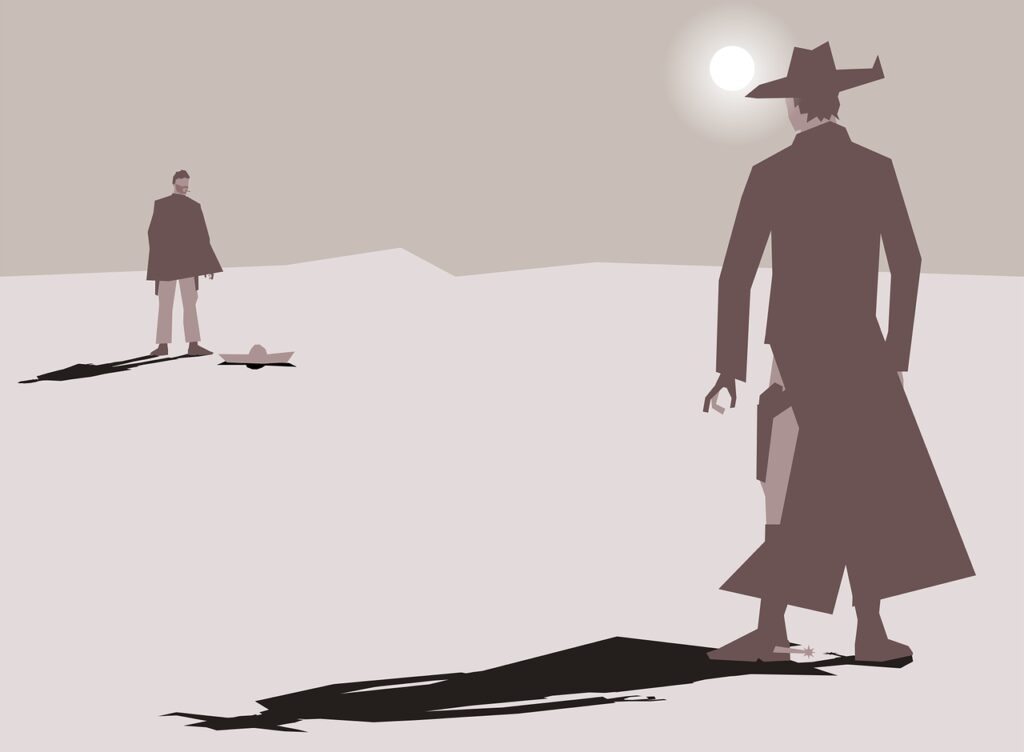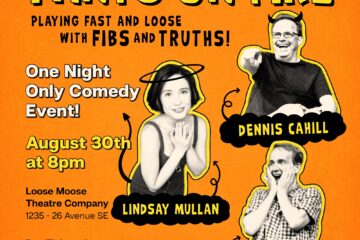MAFIOSO * SPLAT * BANG *GUNSLINGER*
It’s HIGH NOON and you stand challenged by some dangerous varmints.
Who’s with you and who’s against ya?
With barely any warning, weapons are drawn! Do you shoot or hide?
REACT!!! or it’s game over pardner!

This is a long article with a lot of great variations to an exceptionally useful exercise.
I encourage you to read all the way through to give yourself an idea of the possibilities the game holds besides just being a fun warm-up.
Like any game, the variations and way you play is up to you. I think you should always play the exercise the students NEED NOW, and not just the ones you happen to have on your list to play today because you planned for it the night before.
Think about why you are playing it and how you might adapt it to your needs without damaging its worth. Don’t complicate it for complication’s sake. Play the simplest version and build in extra elements naturally as you see use for the students who are playing it.
GAME: Called many things by many people:
MAFIOSO * SPLAT * BANG *GUNSLINGER* SHOOTOUT * CROSSFIRE
ORIGIN: Unknown
BENEFITS: (so many…)
- Reaction
- Staying focused
- Dealing with Failure
- Thinking outside the box
- Awareness
- Connection
- Adaptation
- Perspective
- Communication
- Control
- Name game
# PEOPLE: Groups – 6 or more, standing in a circle
GOAL: React to a changing environment by taking on the role of dueling gun slingers or innocent bystander based on what the story needs from you. Then, win or Lose, STAY PRESENT IN THE GAME! Not as easy as it sounds.
PROCEDURE:
- Everyone stands in a circle (including you).
- Tell the group that you will call out the first name. (don’t call the name of the people on either side of you)
- The person whose name is called must IMMEDIATELY drop to the ground so they won’t be caught in the upcoming crossfire.
- The two people on either side will turn and shoot mime guns at each other and say, “BANG“. (The sound is important as it helps determine what comes next)
>The person who shot first wins the duel and remains standing.
>The person who was hit by the bullet sits down in their spot and is out of the game (but still has one more job)
>The person whose name was called and got out of the way of the bullets stands back up and is still in the game. - The person who was last shot, calls out the name of someone still standing and we repeat the process in the previous steps until there are only two people left standing.
- The last two players alive in the game stand back to back in a duel for the FINAL SHOWDOWN.
- The last person shot in the regular game chooses a category (CITY NAMES, NAMES OF CHOCOLATE BARS, etc).
- That person controls the showdown by saying words that will make the two players in the duel step away from each other or turn and shoot!
> If the word is NOT IN THE CATEGORY – (MONKEY, TELEPHONE, NOT IN THE CATEGORY OF CITY NAMES.), the two standing back to back take one step away from each other for each word.
>If the word IS IN THE CATEGORY (PARIS, OSLO, CALGARY, eg) the two in the showdown turn and shoot.
BANG!!! FIRST TO FIRE WINS
The game is pretty simple but the lessons scattered everywhere may take some magnifying.
SEE WHAT THE AUDIENCE SEES
This game shows the same story over and over, with different outcomes.
1 innocent bystander tries to avoid the gunshots of two gunslingers. 1 person will not survive. The story’s outcome is not predictable and the audience sometimes sees the story differently than the improvisers.
Shawn stands between Tina and Jonah.
Shawn’s name is called. Shawn should get down immediately because Tina and Jonah are turning to fire, but Shawn isn’t paying attention. He starts moving too late to get out of the way
Jonah turns and shoots first – BANG!!!!
The audience watches an odd story play out. Tina grabs an imaginary wound and falls to the ground. “Good Shot!” She says as Jonah smiles proudly, and holsters his gun.
Then they both look between them and they see Shawn laying on his back, dead for the past 15 seconds with arms crossed over his chest.
Tina and Jonah look confused but the rest of the onlookers agree, Shawn took the bullet.
Sometimes the competition and pressure build up so that we don’t see the same story that the audience is watching. The competitors only see the story in their minds and ignore the ACTUAL story in this incident where the bystander got hit.
Eventually, participants learn that they aren’t TWO PEOPLE competing to WIN against each other. They are THREE PEOPLE competing to SEE THE SAME STORY AS THE AUDIENCE.
If some participants consistently see the story “wrong”. (Usually, a person who always thinks he shot first… even when he didn’t.) Add the “BUZZARD EFFECT”!!! – See VARIATIONS (below).
“BANG BANG” – It’s a Tie!!!
This is a fantastic moment. Shawn gets out of the way in time. Tina and Jonah SHOOT at the same time.
Without fail, one or both of them look to the teacher hoping to have the teacher settle the dispute of who won and who lost. That behaviour is an ugly reminder of polite school-learned control.
Improvisers playing too close to the rules fail to take the common-sense initiative to clarify the story.
I think it’s great to create rules and then throw improvisers into a situation where the rules don’t fully address all the possibilities. They will invariably turn to the authorities for answers. That’s when you say, “SORT IT OUT FOR YOURSELF – NOW!!!”
It’s crazy that people need permission to think for themselves but that’s how most of us were trained.
One person will shoot again. They learn the lesson that if the problem isn’t solved, they have to take action in this game and hopefully in a scene. BUT…. this leads to a new problem.
Machine Guns and Bazookas…
With their newfound power of initiative, participants take great steps to optimize their wins.
Shawn drops down when he hears his name. Tina and Jonah turn, firing non-stop machine guns, loud and big. Jonah is louder and throws a few grenades to secure a win. But… what’s the purpose?
The unfortunate lesson here is that “louder” and more “aggressive” wins.
Not a great lesson for improvisers.
We want improvisers to see and react to what is necessary to support their partner, not to overrun their partner in favour of glorifying their own ego for a win.
SO! we adapt the game again with an elegant rule. GUNS ONLY HAVE ONE BULLET and the gun CAN be reloaded if there’s no clear ‘winner’.
This forces partners to look at each other and read them for their responses. Will they die or do they expect you to? If they expect you to die, will you quickly agree or disagree? Have they already started to reload??? It might already be too late for you because you haven’t responded to the non-verbal signals your partner gave you.
PLAY YOUR PARTNER – DON’T JUST PLAY THE GAME!
I let him win – TO BE NICE….
There are those amongst us who believe to support your partner, it’s sometimes nice to let them win. THAT’S A TOTAL SHIT ATTITUDE!!
First of all, don’t be so arrogant to believe that you are the one who should LET people win or not.
Secondly consider how horrible it feels when someone “lets you win”. Thanks Mom.
Thirdly, the audience wants honesty. They don’t want a false reality that leaves them unfairly at the whim of contrived social values. PLAY TO YOUR HIGHEST LEVEL.
IF you want to increase “fairness”, “PLAY YOUR ARROGANCE”. Here’s what I mean:
“Letting someone win” assumes that you think you are better than your partner. If that’s what you feel, then instead of “letting” them shoot you, practice playing closer to the line of failure. Pull your gun at the last minute because you know you can. OR, use the other hand. Challenge yourself even when it makes it more difficult. Make it “more fair” by not relying on old easy behaviour. Push yourself past your habits.
Put yourself at a disadvantage and see if you can still win. NOW, if you lose and are fairly shot, your defeat is so much more rewarding to your partner and to those watching… you evil bastard.
You understand that you are much more supportive of your partner when you push them and yourself into an honest outcome even if it means you challenge yourself to find reasonable ways to do it.
THE ‘LOSER’S’ EXTRA ROLE!
Most teachers want to keep control of the game by always being the one calling the names. DON’T BE LIKE THAT!
Give students control. There are lessons for them in this process (and probably for you if you are the type of teacher who wants to control every action in the classroom).
What happens when we “lose”, when we are shot and sit down?
- We disengage.
- We question what happened.
- We are disconnected.
This is a problem on stage when we have moments of self doubt.
the task for the “loser” to DO SOMETHING when they think their job is done is a lesson in engagement and dealing with failure. Being responsible just to call out the next name in the game puts you into a healthier state. You have to think about the group before you think about your mistake/loss.
And watch how often this scenario plays out. The player is shot. They sit down and they go into their head. And everyone waits. And waits. AND MAYBE- they come back to the group surprised, “OH YEAH!!! I have to call the next name.” And maybe they don’t and wonder why people are staring at them.
Don’t let others yell at the person they are waiting for, “CALL A NAME – CALL A NAME!!!”
Explain that it’s part of the process that you want to see how long it will take people to become present again. Let them know it will happen to everyone. Some people may eventually need reminding.
Play another round (if there is a disengagement problem) where you challenge them to have NO DELAY between being shot and calling the next name.
TEACHING TIPS:
This game – LIKE ALL THINGS WE DO, PLAY or LEARN) evolves naturally. Students play at one level when they first learn the game. They try to understand and sort through rules and the game is played through an intellectual filter.
Then it flows and people adapt as they learn how to play and how to optimize their success. Your job is to watch as they adapt the game to suit their ego and then adapt it to teach a better lesson.
Don’t steal the process from the student. Don’t teach it all at once. Let students have fun and discover it one step at a time. Some groups need different parts of the lesson at different times.
AND PARTICIPATE IN THE GAME WITH THE STUDENTS with part of you mind open to attending to all the student’s needs.
VARIATIONS:
SPLAT
For those of you who have had enough guns and violence… and maybe want to ban them for a while, PLAY WITH PIES!!!
I don’t know about how our games affect our attitudes but when one teacher took offense to the game I offered the alternative of pies. It worked really well.
Instead of “BANG” – you throw a pie and yell “SPLAT”.
Instead of reloading a gun, you fill a pie plate up with whip cream every time you “SPLAT!”
Mexican Standoff
I love this lesson. It works ONCE as a teaching tool for each group so use it well later in the experience.
You get to the end of the regular game but this time you say…
“Why don’t we have the last THREE people stand back to back.”
Tell them that the rules have changed and they have to adapt to these new rules:
- THREE PEOPLE COMPETE INSTEAD OF TWO
- EACH PERSON HAS ONLY ONE BULLET WHICH MUST BE FIRED (EVEN IF YOU ARE KILLED)
- NO RELOADING
In our example, the category chosen is “BODY PARTS”. The participants are standing back to back. They’re ready to go.
Words are called –
- “JANUARY” – They take one step away from each other. The tension is in the air.
- “ARM-Y” – Ohhhh they almost turn to fire. They take another step.
- “SHOULDER!!!!!”
All three turn and fire immediately!!!
BANG BANG BANG!!!! People are falling and laughing… but they failed to see how the new rules could have affected them.
While the original duel is about speed. “TURN AND FIRE!!! QUICK!!!” The Mexican Standoff rules change things. The rule is that you only have one shot and that shot can be fired EVEN IF YOU ARE KILLED…This game is now about intelligence and tactics.
Having learned and practiced that they must fire fast or die, NO ONE adapts to the idea that you don’t have to be fast.
Three guns are raised and Shawn and Tina shoot quickly and both coincidentally fire at Jonah!
Jonah however understood the game and knew it wasn’t about speed. This thoughtful little man now holds a single shot. Even though he has received both Shawn and Tina’s shots, he can now make an impact by choosing who he wants to win by placing his bullet on whichever target he wants.
Or not! Jonah surprisingly fires into the sky and falls to the ground, giving Tina and Shawn a tie for the win. What a brave and smart young man thinking outside the box like that!
You might think this is a lot of effort for a variation with little replay value BUT… its impact is really strong when they understand that Improvisation is NOT ALWAYS ABOUT SPEED or getting stuck to an old pattern of behaviour.
Sometimes you need to think. Sometimes you need to adapt to the subtle change and stop behaving as you always do.
The BUZZARD EFFECT –
There can be groups or individuals that refuse to see what everyone else sees.
- A person Always thinks he shot first even though it’s clear he hasn’t
- A person gives in easily even though there was clearly a tie or the other person lost
- The bystander was clearly hit but the shooters don’t see it.
 For whatever reason, some performers see a different story than the one the audience saw. This oblivious state is not a good way for improvisers to behave. Sometimes you want to introduce this lesson taught from the group perspective.
For whatever reason, some performers see a different story than the one the audience saw. This oblivious state is not a good way for improvisers to behave. Sometimes you want to introduce this lesson taught from the group perspective.
Buzzards only want to eat the dead. So, in this variation, if anyone watching sees the WRONG person dead at the end of the round, they make a short sharp BUZZ sound. Bzzzzzzzzzzzzzzzzzz! (No it’s nat a buzzard’s sound but… you get the picture)
If there’s only one or two Buzz’s, just move on. If there is a majority of Buzz’s, CHANGE who is dead until the audience is happy. It’s up to the performers to figure it out.
WALKING MAFOSO
In this variation, I wanted a larger focus on stage awareness. Where is your partner on the stage?
- Everyone is walking around on stage.
- TWO NAMES are called.
- Those two must find each other and shoot as in the original game, towards each other.
- ANYONE standing in the line of fire between the gunslingers is dead and out of the game. They should be aware and get down before the bullets are fired.
- (One of the dead people calls the next name.)
CAUTIONS: – MAKE SURE THERE IS ENOUGH SPACE BETWEEN PLAYERS. I’ve seen people playing too close get hit in the head as the gangsters raise their guns quickly to fire.




0 Comments